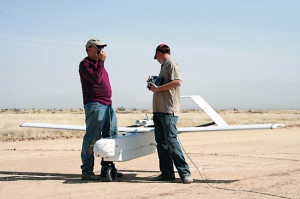Neat story. I am the BAT 4 External pilot for the mentioned flights. I am holding the R/C controller: Very interesting study. Take a look.
Video:
https://www.youtube.com/watch?v=eYu9N17U8dg
"Unmanned aircraft aids NMSU Ag research
by Press • 11 April 2014
By Emily C. Kelley
LAS CRUCES, N.M. >> A small group of researchers and technicians recently gathered on a dirt airstrip at the USDA Jornada Experimental Range to launch a Bat 4 unmanned aircraft on a mission, flying through both military restricted airspace and the National Airspace System.
“We do rangeland monitoring, and it’s a way to gauge rangeland health to see how the plants are doing over the course of the year,” said Connie Maxwell, USDA biological science technician and NMSU affiliated faculty member.
This specific flight is one of a series that will monitor plant growth cycles for a USDA scientist studying vegetation response to climate. The scientist selects the flight dates in conjunction with satellite over-flights to compare the images.
“We were doing an imagery flight,” said Maxwell. “We have several sites out on the Jornada that we do repeat imagery on. This was a baseline flight for the year, before things start growing. In a couple of months, we’ll go back and do the same flights we did that day, and see the green of the vegetation out there, and then later on in the year, we’ll see peak times – we’ll catch peak biomass, then at the end of the year when the plants start dying.”
The vegetation study is one of many that Maxwell and her colleague Amy Slaughter, USDA biological science technician and NMSU affiliated coordinator and graduate student, support with imagery from unmanned aircraft flights each year.
Each flight is the culmination of several weeks of work, determining the logistics of what the crew will do on flight day.
“As many times as we’ve done these flights, they’re never the same. There’s always some kind of a change, so you basically have to start from scratch,” Maxwell said. “We got a new airplane that we just started using last year, so basically, we have to redo everything because it’s a totally different system.”
The use of unmanned aircraft at the Jornada Range dates back to 2006.
The Bat 4, manufactured by the MLB Company, has a 13-foot wingspan. The smaller Bat 3 that Maxwell and Slaughter still occasionally use has a six-foot wingspan, but carries a much smaller payload. A payload is the total complement of equipment carried by the aircraft, in this case, cameras. The Bat 4 is able to carry a 20-pound payload of two cameras — a Canon SLR 21-megapixel camera and a Tetracam mini multi-camera array. With each Tetracam exposure, separate bands of visible or near-infrared radiation are captured by six camera lenses to form a separate, monochromatic image on each camera sensor. The images allow researchers to make several determinations about the depicted vegetation.
http://www.demingheadlight.com/deming-opinion/ci_25538216/unmanned-aircraft-aids-nmsu-ag-research"

Comments
Thanks for chiming in on the question Corey,
Yes he is correct we have had a functioning UAS FTC with an FAA accepted airworthiness process for UAS since 2007. The USDA Bat 4 is only one of the systems that we work with. I am the Sr. External UAS Pilot with NMSU PSL, and I also work with the FTC as a Safety Analyst/Subject Matter Expert. I have work with UAS for approx. 10 yrs and R/C for 24 yrs. I got into the DIY Drone side of the hobby 3 yrs ago. It has allowed me to continue my knowledge and skills. Please follow this link for any information: NMSU Physical Science Laboratory UAS Flight Test Center.
Corey,
I wasn't involved in this work and I'm not affiliated with the university, but NMSU has had a UAS Flight Test Center with a up and running for a couple of years, at least. You can read more about it here: NMSU Physical Science Laboratory UAS Flight Test Center.
How are you handling COAs in the NAS and what channels did you have to go through to get in restricted airspace?